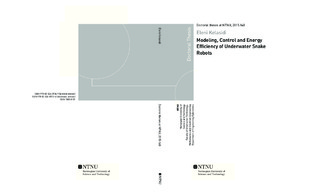| dc.description.abstract | This thesis is mainly motivated by the attribute of the snake robots that they
are able to move over land as well as underwater while the physiology of the robot
remains the same. This adaptability to different motion demands depending on the
environment is one of the main characteristics of the snake robots. In particular,
this thesis targets several interesting aspects regarding the modeling, control and
energy efficiency of the underwater snake robots.
This thesis addresses the problem of modeling the hydrodynamic effects with
an analytical perspective and a primary objective to conclude in a closed-form
solution for the dynamic model of an underwater snake robot. Two mathematical
models of the kinematics and dynamics of underwater snake robots swimming in
virtual horizontal and vertical planes aimed at control design are presented. The
presented models are derived in a closed-form and can be utilized in modern modelbased
control schemes. In addition, these proposed models comprise snake robots
moving both on land and in water which makes the model applicable for unified
control methods for amphibious snake robots moving both on land and in water.
The third model presented in this thesis is based on simplifying assumptions in
order to derive a control-oriented model of an underwater snake robot moving in a
virtual horizontal plane that is well-suited for control design and stability analysis.
The models are analysed using several techniques. An extensive analysis of the
model of a fully immersed underwater snake robot moving in a virtual horizontal
plane is conducted. Based on this analysis, a set of essential properties that characterize
the overall motion of underwater snake robots is derived. An averaging
analysis reveals new fundamental properties of underwater snake robot locomotion
that are useful from a motion planning perspective.
In this thesis, both the motion analysis and control strategies are conducted
based on a general sinusoidal motion pattern which can be used for a broad class
of motion patterns including lateral undulation and eel-like motion. This thesis
proposes and experimentally validates solutions to the path following control problem
for biologically inspired swimming snake robots. In particular, line-of-sight
(LOS) and integral line-of-sight (I-LOS) guidance laws, which are combined with
a sinusoidal gait pattern and a directional controller that steers the robot towards
and along the desired path are proposed. An I-LOS path following controller for
steering an underwater snake robot along a straight line path in the presence of
ocean currents of unknown direction and magnitude is presented and by using a
Poincaré map, it is shown that all state variables of an underwater snake robot,
except for the position along the desired path, trace out an exponentially stable periodic orbit. Moreover, this thesis presents the combined use of an artificial potential
fields-based path planner with a new waypoint guidance strategy for steering
an underwater snake robot along a path defined by waypoints interconnected by
straight lines. The waypoints are derived by using a path planner based on the
artificial potential field method in order to also address the obstacle avoidance
problem.
Furthermore, this thesis considers the energy efficiency of underwater snake
robots. In particular, the relationship between the parameters of the gait patterns,
the forward velocity and the energy consumption for the different motion patterns
for underwater snake robots is investigated. Based on simulation results, this thesis
presents empirical rules to choose the values for the parameters of the motion
gait pattern of underwater snake robots. The experimental results support the derived
properties regarding the relationship between the gait parameters and the
power consumption both for lateral undulation and eel-like motion patterns. Moreover,
comparison results are obtained for the total energy consumption and the
cost of transportation of underwater snake robots and remotely operated vehicles
(ROVs). Furthermore, in this thesis a multi-objective optimization problem is developed
with the aim of maximizing the achieved forward velocity of the robot and
minimizing the corresponding average power consumption of the system. | nb_NO |
